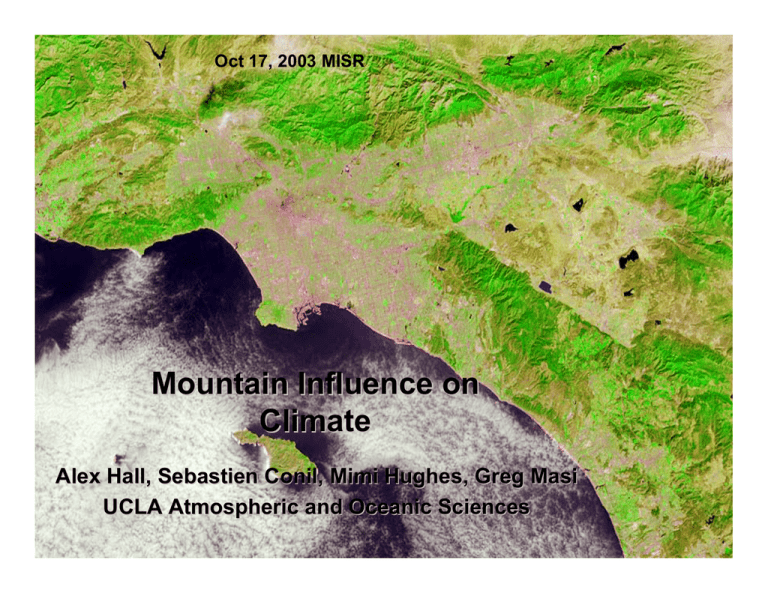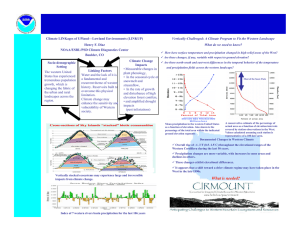Mountain Influence on Climate Alex Hall, Sebastien Conil
advertisement

Oct 17, 2003 MISR Mountain Influence on Climate Alex Hall, Sebastien Conil, Mimi Hughes, Greg Masi UCLA Atmospheric and Oceanic Sciences SIMULATING MOUNTAIN CLIMATE Experimental Design model: MM5 boundary conditions: eta model reanalysis resolution: domain 1, 54 km, domain 2, 18 km, domain 3, 6 km time period: 1995 to present. One can think of this as a reconstruction of weather conditions over this time period consistent with three constraints: (1) our best guess of the largescale conditions, (2) the physics of the MM5 model, and (3) the prescribed topography, consistent with model resolution. Comparison of “dynamical downscaling” vs “statistical interpolation” DIURNAL CYCLE AMPLITUDE There are large gradients in this quantity, with high elevations having amplitudes on the order of 6 degrees C, and low elevations having amplitudes more than twice as large. (Hughes et al. (2005)) Amplitude (m/s) and orientation of August diurnal mountain winds and land/sea breeze, as measured by the difference between the winds at 3PM and 3AM. Upslope flow occurs during the day, while downslope flow takes place at night. increasing potential temperature WARM COLD The S. California atmosphere is usually highly stratified. CONVERGING COLD AIR During the daytime, upslope winds bring cold air to the highest elevations, reducing daily maximum temperature. PRECIPITATION A scatter plot of precipitation vs. elevation shows two distinct clusters with different slopes and intercepts. IN TE R IO R C O A ST L A It turns out that if we divide up the region into a coastal and an interior domain, this corresponds to the two clusters in the precip vs elevation plot. A scatter plot of precipitation vs. elevation shows two distinct clusters with different slopes and intercepts. COASTAL INTERIOR If we regress precipitation against elevation, we can calculate slopes and intercepts for the two clusters. The slope measures the elevation enhancement effect. The intercept measures the precipitation occurring at sea level. Slope and intercept of regression of precipitation vs elevation by calendar month coastal interior coastal adjacent open ocean value interior Southern California Climatological Precipitation (cm/yr) e at im ox pr ap ct re di n io of w flo g rin du in ra ts en ev Some of the effects of topography on the flow result in non-trivial relationships between precipitation and elevation. For example, at the coast, we might expect no orographic enhancement. Yet precipitation is clearly greater than it would be if there were no topography. (Masi et al. 2005) Southern California Climatological Precipitation (cm/yr) e at im ox pr ap ct re di BLO CKE DF LOW n io of w flo g rin du in ra ts en ev Precipitation is enhanced in the coastal zone because of blocked flows that develop parallel to the coast as low-level air masses are forced toward the interior. Once this blocked flow is in place, the moisture-laden onshore flow must surmount it in addition to the topography, enhancing precipitation well away from the coastal ranges. This is another example of how local dynamics profoundly affect the geographical distribution of a quantity relevant to climate. The precipitation field recorded in the PRISM data set shows a rough consistency with the simulation. Not only is the overall magnitude very similar, but so is the geographical distribution. If anything, the coastal blocking effect is more apparent in the PRISM data. SANTA ANAS A view of the Santa Anas from space, taken by the Multiangle Imaging SpectroRadiometer (MISR) on February 9, 2002. The winds simulated by the model during the Santa Ana event of February 9-12, 2002. Note the intense flow, reaching speeds on the order of 10 meters per second, being channeled through mountain passes. The fact that the model simulates this and other Santa Ana events with the correct timing demonstrates that the conditions for Santa Ana events are contained within the boundary condition information provided to the model. Cluster Analysis To classify the regimes of wind variability in Southern California, we performed a probabalistic cluster analysis algorithm (Smyth et al. 1999) on the October to March dailymean winds. The clustering technique provides an quantitative means of defining preferred modes of wind variability. We chose to focus on the wet season because of the interesting combination of phenomena (Santa Ana events and precipitation) during this period. We found that the wind regimes can be well-described in terms of three clusters, which together account for 82% of the days. 10 m winds associated with the Santa Ana regime. Speeds greater than 6 m/s are shaded. The “Santa Ana” regime is characterized by intense offshore flow through mountain passes. Its average duration is 1.7 days and it accounts for 13% of the total days in the analysis. The days belonging to this cluster coincide with extreme dryness. PNA These are the primary modes of pressure variability during when the entire SiberianPacific-North American sector is considered. They are revealed by EOF analysis of 500 hPa NCEP reanalysis data. These correspond with known modes of variability. For example, the top pattern corresponds to the Pacific -North American pattern (PNA). probability of occurrence Here is the chance of occurrence of the Santa Ana wind regime when the normalized magnitude of the various large-scale modes is large, either in the positive or negative phase. The positive phase of PC4 is slightly more likely to be associated with the Santa Anas than its negative phase or the positive and negative phases of the other modes. However, the overall impression is that the large-scale modes have very little predictive power of the local Santa Ana regime. (Conil et al. 2005) Therefore, local modes of variability are related in a non-trivial way to larger-scale forcing. This is the sea level pressure pattern associated with the Santa Ana mode. It consists of a localized high over the Great Basin. Why is this pattern so important for Southern California? 10 m winds associated with the Santa Ana regime. 6 km resolution 54 km resolution A Local Perspective on Climate We show in our examination of (1) The amplitude of the diurnal cycle (2) The geographical distribution of precipitation (3) The Santa Ana mode of wind variability that spatial and temporal climate variability in this mountainous region is either generated by in situ by local processes, or related in a nontrivial way to the large-scale forcing. __________________________ To predict mountain climate change on spatial scales relevant for humans and ecosystems, we must understand these local processes and the complex relationships of large-scale forcing to local variability.





